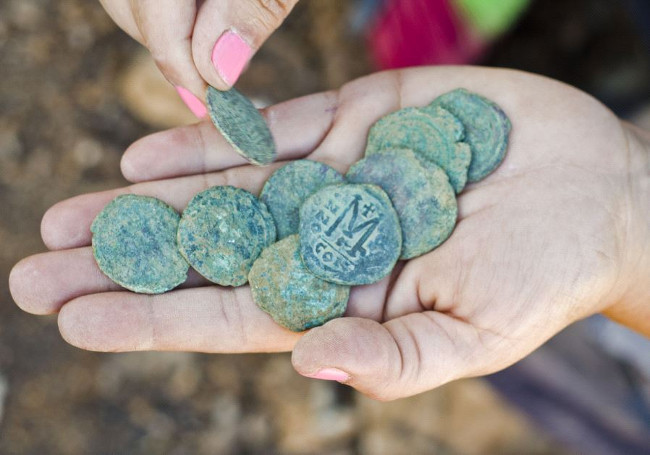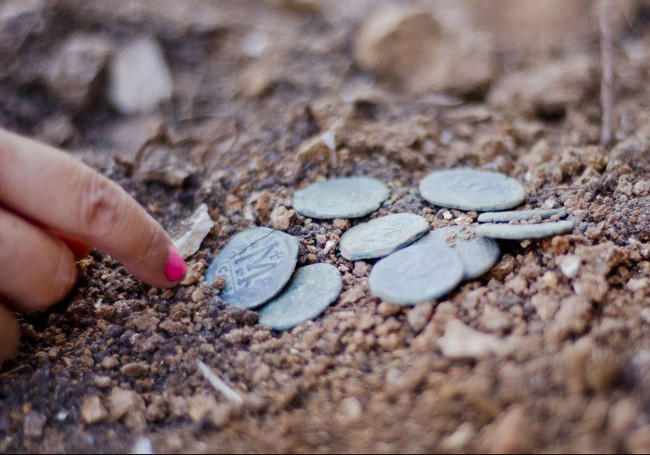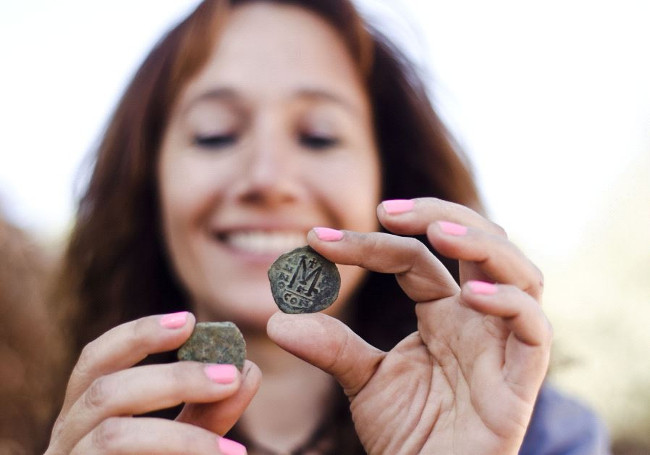9-year-old 1400-year-old Byzantine coins found in the Jerusalem highway
A series of 9 old Byzantine copper coins estimated at 1400 years old have been found in Jerusalem - Israel's Archaeological Authority announced.
Accordingly, there is an archaeological treasure that holds 9 copper coins found by Israeli archaeologists at the highway 1 highway in Jerusalem. It is estimated that these coins were in the late Byzantine period, which is a testament to the invasion of Persians in Jerusalem that had taken place in the past.

According to the Israel Antiquities Agency, these coins may date from the 7th century, on which images of the Byzantine emperors were printed, excavated when the government expanded the highway near Ein. Hemed, 7 km west of Jerusalem.
These include images of Byzantine Justinian emperors (483-565 CE), Maurice (539-602 CE) and Phocas (547-610 CE), all wearing military attire and a horizontal diagonal printed on the Coins.

Annette Landes-Naggar, director of the excavation on behalf of Israel's Antiquities Agency, said the coins were found in a cloth bag deep in the ground under the wall of an ancient wine tree.
' This small treasure is buried in a large crushed rock area, it is possible that the owner had hidden this bag when something happened and hoped to get back to the bag'. But now it's too late, we've found it '- she added.

Clearly, these 9 coins appeared in the period when the Sassanids and Persians invaded and ended the Byzantine Emperor's Dynasty in Israel in 614 AD.
Landes-Naggar said: " Because of the fear of the invasion, the inhabitants of the area felt their life was in danger, so they buried their money in the wall next to a vine. However, Landes- Naggar also said: "This place is located along the main road from the entrance to Jerusalem city and used by Christian pilgrims to enter the city. And it is possible that some ancient settlement has been built along this highway . '
Dr. Amit Shadman, an archaeologist, said authorities and the Israeli Pipeline Company will work together to maintain the area to support excavation and conservation.
You should read it
- The discovery of an ancient Persian stele carved from King Darius I in Russia
- 5.6 tons of coins were excavated under the house in Jiangxi, China
- Stock of ancient silver coins found near Mezdra of Bulgaria
- The 1,600-year Roman tomb with ancient coins was discovered in Somerset
- Mysterious ancient coins print 'alien' pictures
- First time in Israel: Ancient deer bones were discovered
- Found four Roman rust coins in Japan yet explanation
- Archaeologists unexpectedly discovered Byzantine Monastery
- 7 most exotic and interesting coins in world history
- Ancient ancient embankment found in Aswan, Egypt
- Found the Roman ancient water tank under the warehouse in Turkey
- Interesting mysteries about currency in human history
May be interested

The largest rock was excavated in South India

Found 50 human bones in the cave, the result of the worst family slaughter in Scotland

Unexpectedly excavated the statue of Tiye Queen in Luxor, Egypt

Workers on the Metro line in Rome accidentally discovered an ancient water pipeline

Ancient urban area found at the construction area of Hyatt Sofia

The world's largest 40 ton ancient rock has just been discovered in Telangana






 Archaeologists unexpectedly discovered Byzantine Monastery
Archaeologists unexpectedly discovered Byzantine Monastery Coins are found in fields of nearly 1,500 years old
Coins are found in fields of nearly 1,500 years old Stock of ancient silver coins found near Mezdra of Bulgaria
Stock of ancient silver coins found near Mezdra of Bulgaria 7 most exotic and interesting coins in world history
7 most exotic and interesting coins in world history Found traces of the ancient Roman Battlefield in Jerusalem
Found traces of the ancient Roman Battlefield in Jerusalem Found four Roman rust coins in Japan yet explanation
Found four Roman rust coins in Japan yet explanation